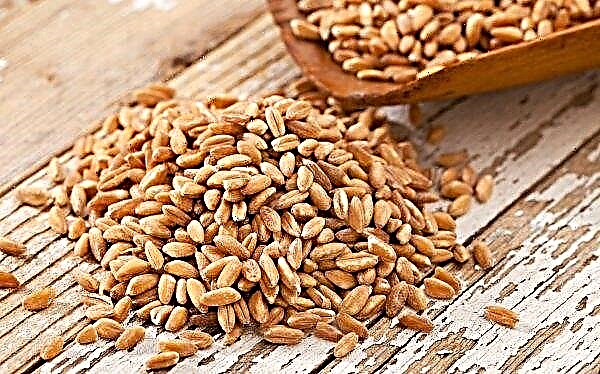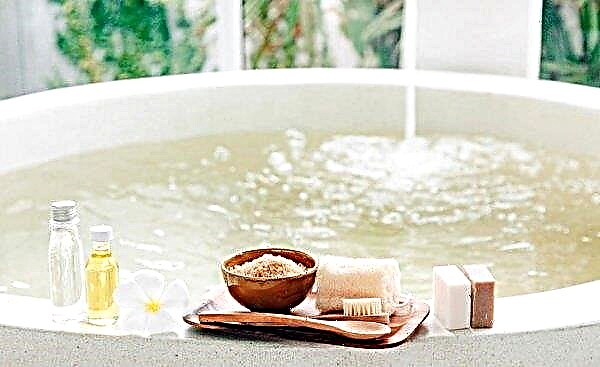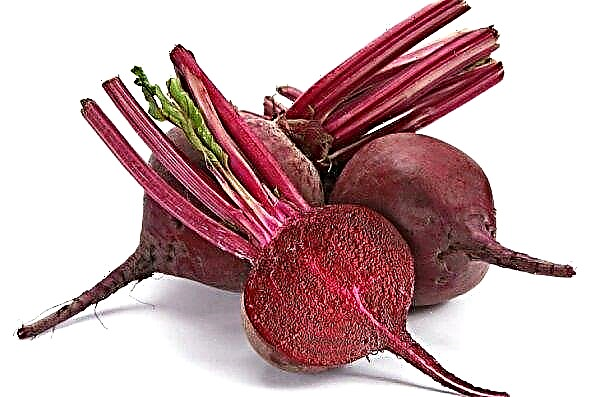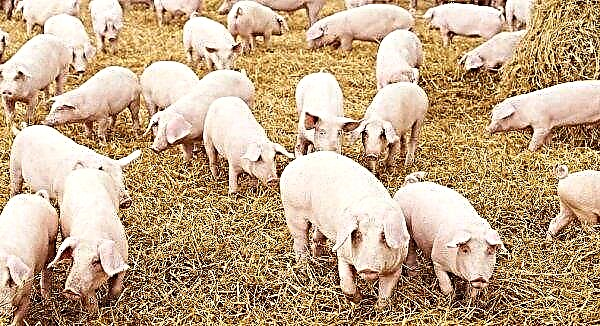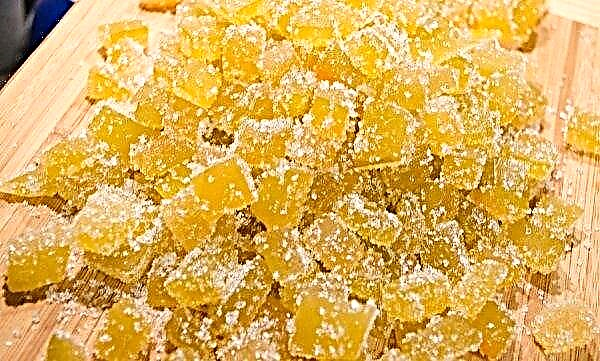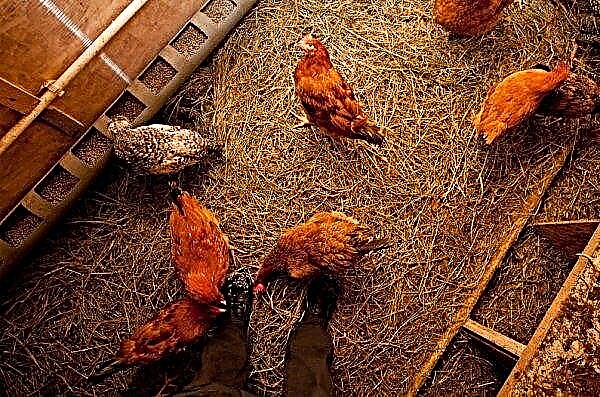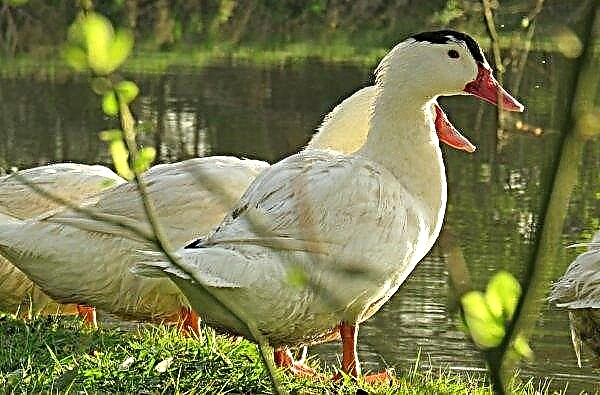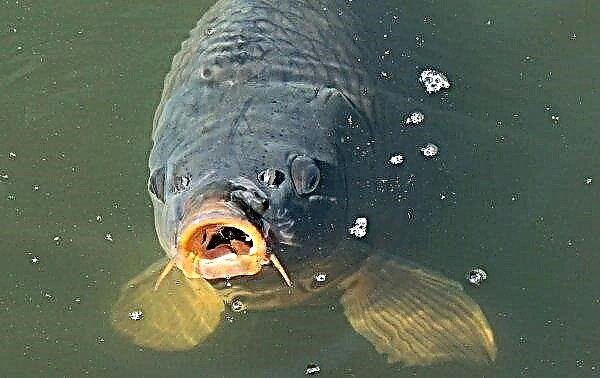Growing potatoes, many vegetable growers prefer to choose early or mid-early varieties in order to be able to get two crops per season. A variety suitable for these criteria is Tiras potatoes. About its characteristics and the nuances of growing - today's article.
Characteristics and description of the variety
The table variety forms medium-height bushes. The foliage is elongated, bright green with a serrated edge. It blooms with dark lilac baskets on a straight thick peduncle.
Tubers in the form of an elongated oval, with a flat surface and shallow eyes. Smooth, light peel casts a pink tint. The mass of tubers is 115–140 g. The pulp is not watery, with an average starch content (not more than 15%), white.
Did you know? Despite the fact that potatoes — cultivated plant, its berries are poisonous. For death, just eat 2–3 berries.
Selection history
The variety is the fruit of the work of scientists of the experimental station of the Institute of Potato named after A. N. Zasukhina at the National Academy of Sciences of Ukraine in the Zhytomyr Region, p. Fedorovka. The variety passed a successful test in Ukraine, Moldova, Belarus, in the central and southern regions of the Russian Federation.
Productivity
From 9 to 12 tubers are formed under each bush; the fruits are uniform in shape and size. The output of marketable products is 93%. 210-460 centners are harvested from 1 ha; the amount depends on growing conditions and soil composition.
 Recommended growing areas: steppe, forest-steppe and woodland
Recommended growing areas: steppe, forest-steppe and woodland
Ripening time
The plant begins to form tubers already on the 10th day after planting. The first potato crop can be harvested already on the 42–45th day. The second tuber crop is harvested after 70–80 days after emergence.
Pros and cons of the variety
The first difference from other varieties with similar characteristics, as well as the dignity of the variety, is the ability to develop and bear fruit in any climatic conditions and on any soil.
- Other benefits:
- early ripening;
- the ability to harvest twice a season;
- attractive presentation;
- resistance to scab, cancer and nematode;
- transportability;
- high safety indicators (93% of the total mass);
- long shelf life - 5-7 months.
The disadvantage is the average resistance to late blight and viral diseases.
 The variety is suitable for two crops.
The variety is suitable for two crops.
Cultivation agricultural
Planting dates may vary in different climatic conditions, but it is important to consider that the soil must be warmed up to + 6 ° C.
Potato does not require special conditions; it develops on both fertile and poor soils. However, it is sensitive to excess moisture.
Important! Waterlogging of the soil will provoke fungal diseases of the variety, so the location of underground sources should not be closer than 1.5 m to the surface of the earth.
Choosing a place and preparing the garden
The site is selected illuminated, flat or slightly on a slope. If you want to get the most out of the landings, it is better to prepare the garden bed:
- Bring acidic soil to neutral by adding dolomite flour or lime (400–600 g / m²).
- Saturate lean soil when digging with organics, for example, humus (4–6 kg / m²)
- Add peat to the sandy soil (except for fertilizers), and clay “dilute” with coarse sand.

Crop rotation rules
Planting potatoes in one area twice is not recommended, so as not to provoke the development of diseases and not to create an ideal environment for the propagation of pests.
Good predecessors for Tiras are:
- pumpkin;
- carrot;
- zucchini;
- greenery;
- cereals.
Bad predecessors are considered to be related cultures of the solanaceous family: tomato, sweet pepper, tobacco, eggplant.

Preparing planting material
Seeds must be sprouted before planting. To do this, the selected material without damage and painful spots is placed in wet sand or sawdust. To prevent diseases and insect attacks, the seeds are pre-sprayed with the Fitosporin-M fungicide. For germination, a container with seeds is placed in a warm place for a month. Before planting, long sprouts need to be broken off, otherwise the plant will stretch, form ugly fruits.

Landing pattern
The beds form from north to south. Aisles are located at a distance of 60–70 cm from each other. Pits are dug 30 cm apart. Planting depth depends on soil composition. On heavy clay soils - no deeper than 5-6 cm, on sandy - 8-10 cm, on chernozem - up to 12 cm.
 The variety grows actively on all types of soil
The variety grows actively on all types of soil
Features of further planting care
Tiras does not need frequent watering and top dressing, which makes it easy to care for and does not require much time.
Did you know? The record for peeling potatoes was set by German Linda Thomsen. She managed to clean almost 10.5 kg in just 10 minutes.
Feed and watering scheme
3 top dressings per season are enough for potato. 2 weeks after planting, they are fed with ammonium nitrate (10 g / 10 l of water), fertilizer is applied by the root method of 0.5 l under the bush. During flowering, plants are sprayed on a leaf with an infusion of green fertilizer, diluted 1:10 with water. After flowering, the root method is used to infuse bird droppings (200 g) and superphosphate (30 g), diluted in a bucket of water.
Watering begins 2-3 weeks after planting. The second procedure is carried out during flowering. If it rains regularly, watering is not necessary after flowering. At the ripening stage, the tubers do not need excess moisture.
 It does not tolerate waterlogging in the second decade of the growing season
It does not tolerate waterlogging in the second decade of the growing season
Loosening and weed control
The Tiras variety demonstrates the best crop performance on loose soil. Loosening regularly after rain or watering is necessary. At the same time, weed beds should be weeded.
So that the tubers are not exposed, and the roots of the plant do not overheat, they carry out an earthing up process. The first procedure is carried out when the bush has grown to 20 cm in height. Hilling should be carried out after rains and irrigation, up to harvesting.

Pest and Disease Control
Difficulties in growing can be the defeat of the plant by pests and some diseases. Possible methods of struggle:
- Rust foliage - Bona forte fungicide helps; spray solution is prepared by diluting 2 ml of the drug in 5 l of water.
- Late blight - the drug "Alirin-B" is effective, which, as a biological agent, is used at all stages of the growing season. A solution for spraying is prepared in a proportion of 2 tablets per 1 liter of water, the interval between treatments is 7 days, the multiplicity is 2-3 times.
- Colorado beetle - use the drug "Apache", spraying is carried out with a solution in a proportion of 1 g per 1 liter of water.
- Medvedka - the Medvetox preparation is used against the insect, the granules of which are laid out on the surface of the bed, sprinkled with earth (consumption - 30 g / 10 m²). The biological insecticide "Boverin" is also effective. The dry substance is mixed with sunflower oil, according to the instructions, and applied to the soil, and the liquid is diluted in water (10–40 ml / 10 l of water) for spraying.
Important! The drug "Boverin" is effective against all soil and land insects, and it can be used at all stages of culture development.
Features of harvesting and storage of crops
The peel of the Tiras variety is dense, so it is not afraid of collecting with the help of mechanized means. 2 weeks before the proposed harvest, the tops are cut so that the tubers absorb the maximum amount of nutrients. After extraction from the soil, the tubers are left to dry directly on the bed. After that, they are shaken off the ground and placed in boxes, interbedded with sawdust or straw. For storage, potatoes are placed in a dry room with a temperature regime of 0 ... + 3 ° C, with a humidity of 80–85%. It can be a cellar, a relatively warm, but not heated balcony or porch. Two weeks before harvesting, it is recommended to remove the tops
Two weeks before harvesting, it is recommended to remove the tops
Potato Tiras is worthy of the attention of summer residents, farmers and buyers. This is an ideal variety for making mashed potatoes, toppings for pies and other pastries, casseroles. At home, potatoes are stored until spring, without losing their taste.


